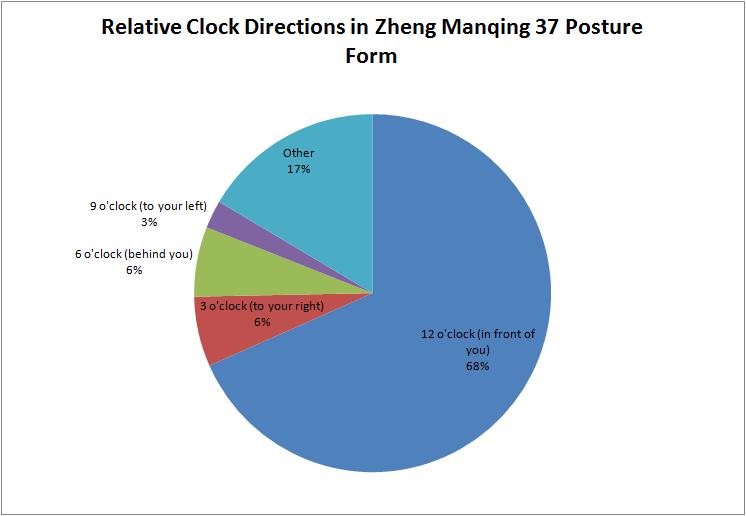Clock Directions in the Zheng Manqing Taijiquan 37 Posture Form
7/6/17
In a previous article on taijiquan, I looked at the cardinal directions we do postures in a form, with the directions fixed. This is thinking about directions from an objective point of view. However, another useful way to think about directions is from a relative point of view.
For example, using a standard analog clock, in front of you right now is direction 12 o'clock and behind you is 6. To your left is 9, and to your right is 3. If you turn around to 6 and stay there, now you are facing your 12 again.

Consider the following table. I list all postures and "sub postures" I could think of. I list the clock direction for that posture when coming from the previous posture.
Posture Number |
Posture Name |
Direction |
| 1 | preparation | 12 |
| 2 | beginning | 12 |
| 3 | ward off left | 12 |
| 4 | ward off right | 3 |
| 5 | rollback | 12 |
| 6 | press | 12 |
| 7 | push | 12 |
| 8 | single whip | 6 |
| 9 | lift hands | 3 |
| 10 | shoulder strike | 12 |
| 11 | white crane spreads wings | 9 |
| 12 | brush knee left | 12 |
| 13 | play the pipa | 12 |
| 14 | brush knee left | 12 |
| 15 | step forward | 12 |
| 16 | deflect | 12 |
| 17 | parry | 12 |
| 18 | punch | 12 |
| 19 | withdraw | 12 |
| 20 | push | 12 |
| 21 | apparent closure, cross hands | 3 |
| 22 | embrace tiger, return to mountain | 430 |
| 23 | rollback | 12 |
| 24 | press | 12 |
| 25 | push | 12 |
| 26 | diagonal single whip | 6 |
| 27 | rely on fist, fist under elbow | 1030 |
| 28 | retreating monkey, right | 12 |
| 29 | retreating monkey, left | 12 |
| 30 | retreating monkey, right | 12 |
| 31 | retreating monkey, left | 12 |
| 32 | retreating monkey, right | 12 |
| 33 | diagonal flying | 430 |
| 34 | cloud hands, left | 1030 |
| 35 | cloud hands, right | 12 |
| 36 | cloud hands, left | 12 |
| 37 | cloud hands, right | 12 |
| 38 | cloud hands, left | 12 |
| 39 | cloud hands, right | 12 |
| 40 | cloud hands, left | 12 |
| 41 | single whip | 9 |
| 42 | squatting single whip, snake creeps down | 12 |
| 43 | golden rooster stands on one leg, left | 12 |
| 44 | golden rooster stands on one leg, right | 12 |
| 45 | separate right foot | 130 |
| 46 | separate left foot | 1030 |
| 47 | turn and strike with heel | 6 |
| 48 | brush knee left | 12 |
| 49 | brush knee right | 12 |
| 50 | low punch | 12 |
| 51 | ward off right | 12 |
| 52 | rollback | 12 |
| 53 | press | 12 |
| 54 | push | 12 |
| 55 | single whip | 6 |
| 56 | fair lady left | 430 |
| 57 | fair lady right | 730 |
| 58 | fair lady left | 1030 |
| 59 | fair lady right | 730 |
| 60 | ward off left | 730 |
| 61 | ward off right | 3 |
| 62 | rollback | 12 |
| 63 | press | 12 |
| 64 | push | 12 |
| 65 | single whip | 6 |
| 66 | squatting single whip, snake creeps down | 12 |
| 67 | seven stars step forward | 12 |
| 68 | step back and ride tiger | 12 |
| 69 | turn body and sweep lotus with leg | 12 |
| 70 | bend bow, shoot tiger | 130 |
| 71 | step forward | 1030 |
| 72 | deflect | 12 |
| 73 | parry | 12 |
| 74 | punch | 12 |
| 75 | withdraw | 12 |
| 76 | push | 12 |
| 77 | cross hands | 3 |
| 78 | conclusion | 12 |
| 79 | bow/saying thanks | 12 |
Here is a graph of the % of clock directions.

Here is a summary of the statistics for each clock direction:
- 12 (in front of you), 68%
- 3 (to your right), 6%
- 6 (behind you), 6%
- 9 (to your left), 3%
- other (various diagonals), 17%
It is clear that the vast majority of the clock direction is in front of you. Interestingly, the percents of right, behind, and left combined are roughly equal to the percent for the diagonals.
One can practice "kata" many different ways, but if done in a self-defense type of way, this tells me that frontal attacks are roughly 2 times as common (ie 68/32) as other types. Also, I'd focus on practicing defending against attacks from your 6, as they are the most difficult to defend against in real life.
Thanks for reading. Happy practice!
Please anonymously VOTE on the content you have just read:
Like:Dislike: